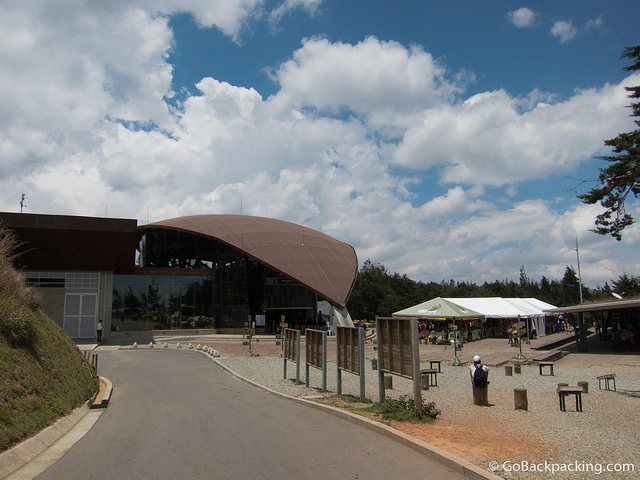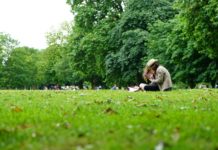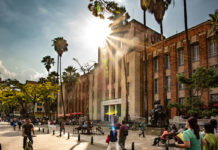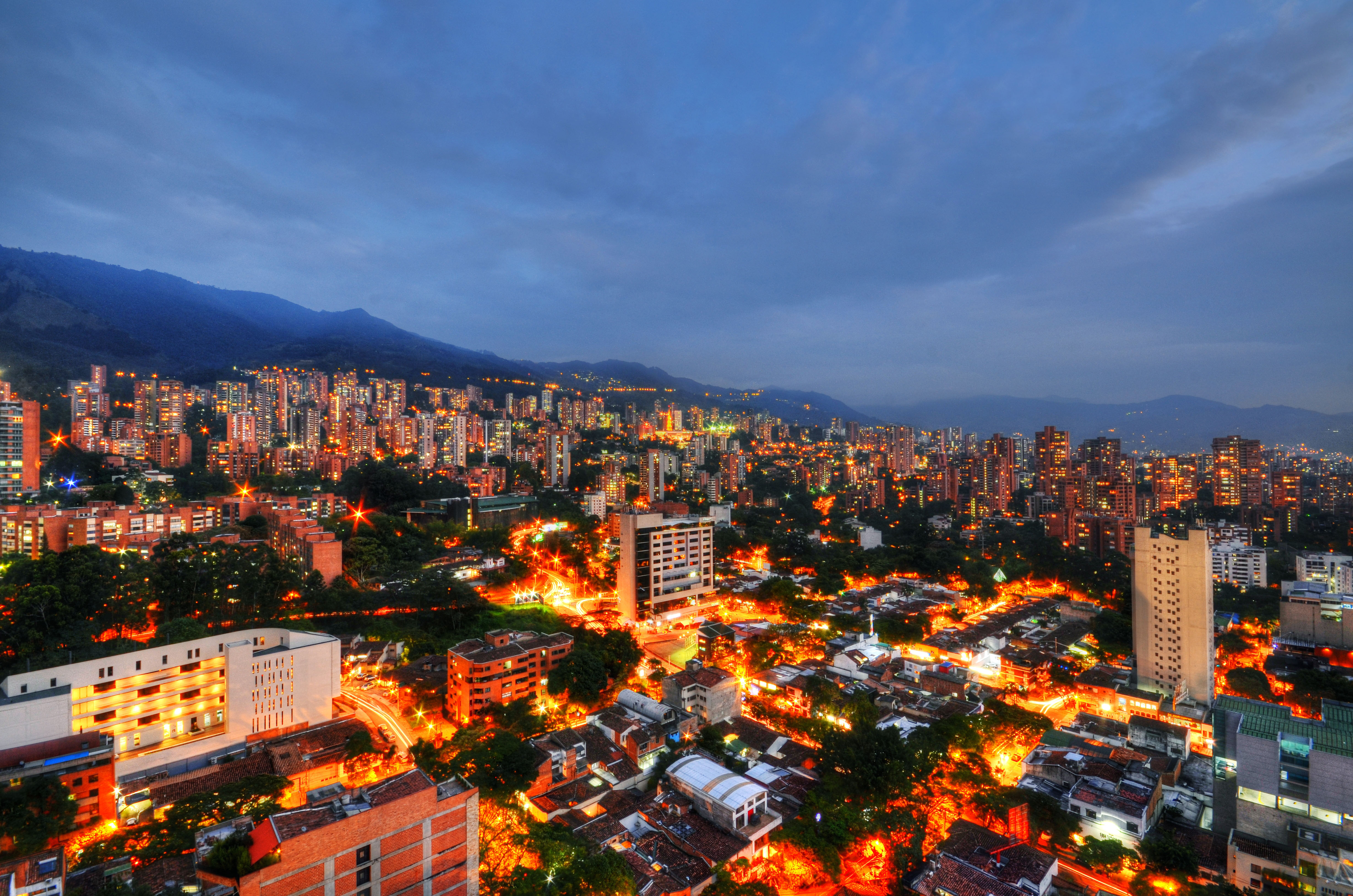
After a delicious breakfast at La Montana Magica, it was time to explore Parque Arví.
I’d once visited the park back in 2010 via the metrocable with a date, but without a tour guide, we were left to simply wander around on our own.
This time, we were in the good hands of Gus, one of the park’s bilingual guides, as well as another Colombian guide.
Our first stop was the future location of the local marketplace which is now located outside the Parque Arví metrocable station. The market is a gathering place for local arts ‘n crafts and food vendors. Facing the square is a 100-year old church.
Our second stop was a lookout tower three or four stories high. Upon climbing up, we had 360-degree views of the park, Santa Elena, and the surrounding countryside.
I was surprised to learn Santa Elena covers a region in length almost equal to that of Medellin. The difference is Medellin was settled in the valley (elev: 1,500 meters), while Santa Elena is perched on a plateau above and to the east (elev: 2,200 to 2,600 meters).
Once the sun goes down, the temperatures drop, so it’s important to bring warm clothes if you’re spending the night. Otherwise, you may feel the effects of the altitude if doing a lot of physical activity, especially walking or biking uphill.

Back on the ground, we began our walk through the park, following a 1,500 to 2,000-year old, Pre-Hispanic road.
Ancient stone walls, mostly covered by dirt and plants, run along both sides of the road. According to Gus, archaeologists are unsure of why these walls were built.
Little is known about the people who built the road in this section of Colombia, but we do know it connected with other roads leading from Central America, through Panama, Colombia, and down as far as Chile.
I found it fascinating that an archaeologically significant road is located so close to Medellin, yet it’d taken me four years to find out it was there. I felt like I was exploring my own backyard for the first time.


During the walk, we spotted small creatures, including a lizard, a bright green caterpillar, and colorful butterflies. I was enjoying the peacefulness of it all.
Parque Arví is a biologically diverse area, as is the whole of Colombia. In this one park alone, there are over 72 species of butterflies, 69 species of birds, and 19 species of mammals.
One of those birds species makes its home in the ground. Gus pointed out holes dug several meters deep into the dirt walls running along one section of the road. The birds, whose name I’ve forgotten, live in these burrows, as opposed to the trees.
Listen closely, and you might be able to hear the baby birds in their nest.
You won’t find any large mammals in the park, such as jaguars and bears, and due to the altitude, nor are there any poisonous snakes or spiders to worry about.

Colombia supplies over 90% of the flowers to the United States, and is a hotbed for orchids.
During our walk, the guides pointed out different varieties left and right.
Every year, as part of the Feria de las Flores (Flower Festival) in Medellin, there’s an orchid competition, with the winners on display at Jardin Botanico (Botanical Gardens).
Gus even said on his days off, he likes to go with friends into Parque Arví in search of orchids.

One of the orchids he showed us was so small, my camera could barely capture its bloom.
According to Gus, this was the smallest orchid in the world. He’d searched online in an effort to find a smaller one, but to no avail.
This is exactly the kind of detail you can learn about and appreciate with a knowledgeable guide, whereas if I were walking the road on my own, I never would’ve seen it.
We were shown other types of flowers too, some of which were edible (and yes, we ate the petals to confirm).

A mirador, or lookout point, allowed us to view the Medellin valley.
Despite the haze that morning, we had a good view of the northern (foreground) and western (background) parts of the city.
For those familiar with Medellin, this view allows you to see such things as the botanical gardens, aquarium, Universidad de Antioquia, metro line, and soccer stadium.

Further along, we encountered evidence of a natural saltwater spring.
The Santa Elena region, which includes Parque Arví, was (and still is) rich in two very important things: salt and gold.
In previous centuries, the Spanish plundered the region for the gold. The salt was used for trading, as well as food preservation.
Where you have a major road, you have a trade route, and thus people living and working in close proximity.

The Sabanas school was once used in the early to mid 20th century as a place for teaching 3rd graders. There are older residents of Medellin who still remember attending this school.
Before it was a school, the buildings were used as a military recruitment place, if I recall correctly (but don’t quote me on that).

Our nature walk eventually lead us to an asphalt road, where we hopped on blue bicycles for the 10-minute ride to the Parque Arví metrocable station.
The bicycles, which feature a basket for belongings, and come complete with helmets, are free to use for visitors. All that’s required is a form of identification, such as a passport, driver’s license, or cedula.
This particular program is in partnership with EAFIT University. Similar ones have also been established in Medellin to help provide students with free, eco-friendly transport between metro stations and the universities.


We dropped off the bikes and took a walk around the metrocable station, and market (which as I mentioned earlier, will move to a new home in the future).
I took the opportunity to try a few new Colombian sweets, including solteritas, which are like an orange creamsicle.
9 out of 10 paisas agree, these treats are a little taste of heaven.
You can also find fresh, locally grown fruits such as blackberries, blueberries, strawberries, and uchuva, as well as handmade jewelry for sale.
Feel free to haggle for souvenirs, but the prices are already cheap.

Lunch was at a vegetarian restaurant, Cable a Tierra, a few minutes walk from the metro station. Just look for the “cafe organico” banner, and walk down the path.
Menu items include soup of the day, veggie burger ($3.83, recommended), quesadilla, cazuela de friojoles, and lasagna.
Try a glass of the warm ginger and passion fruit tea for just 2,000 pesos ($1.09).
Parque Arví is easily accessible from Medellin via the metro line.
Take Line A north to the Acevedo stop, and switch to the metrocable (Line K) to Santo Domingo. In Santo Domingo, you must disembark, and pay separately for the metrocable to Parque Arví (Line L).
To get the most out of your visit to Parque Arví, leave Medellin by mid-morning. This allows for transit time, as well as time to explore the park.
Believe it or not, everything I’ve written about so far accounts for the first half of our Saturday in Santa Elena. In the next post from the trip, we’ll meet the silleteros, the men and women who create and carry the flower displays in Medellin’s annual flower parade.
_________
My visit to Santa Elena was at the invitation of Paso Bueno to promote tourism in the region.













Hi Dave!
How did you go about finding Gus to guide you? I’ve read a ton of negative reviews of the park by people who were left on their own to wander around with no direction and no idea of what to do…we are coming to explore Medellin in March and would love to check out the park with a guide like Gus!
We are just planning our trip today, your site is amazingly helpful, thank you!
I went on a press trip hosted by the non-governmental organization of local businesses that promote tourism to Santa Elena. They surely chose Gus for good reason. I wasn’t aware of the negative feedback guides were getting. That’s unfortunate.
here I share them our BiciTour in Santa Elena
https://www.youtube.com/watch?v=QdER2sOXMzI